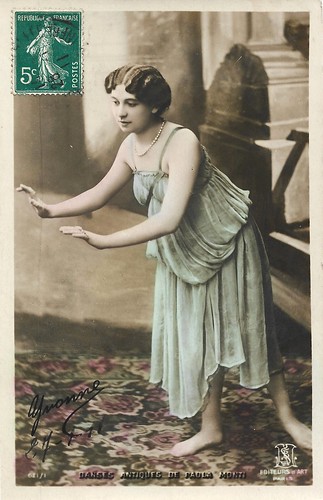
French postcard by ND Phot., no. 82. Photo: Manuel. Caption: Paola Monti (Mathurins). The Théâtre des Mathurins was opened in 1897 and is a still-existing theatre in Paris, in the 8th arrondissement.

French postcard by M.A. I. Photo: Jean Bart. Caption: La coupe d'or. Versez le vin vermeil, Le vrai sang du soleil (Pour the vermillion wine, The true blood of the sun).

French postcard by M.A. IV. Photo: Jean Bart. Caption: Je veux, tout d'une haleine, Vider la coupe pleine (I want, all at once, to empty the full cup).
The Dance Macabre
Who was Paola Monti, sometimes also written as Paula Monti? Very little is known about Monti, her life dates and origins, as well as her stage career.
What is known is that she performed on the Parisian stages in the 1900s, e.g. in the play 'La strega/The Witch' as well as in a series of dances called 'Les danses antiques/grecques de Paola Monti'.
She performed these dances around 1903 on various occasions and at various locations, such as the Parisiana. Monti's barefoot dances caused a stir.
In January 1904, Monti first performed at the Mathurins a new dance, 'the Dance Macabre', inspired by the Tanagra 'Pleureuses' sculptures at the Louvre. The audience applauded the original dances, which Monti danced barefoot and barelegged.
In 1904, Monti was considered among the best female artists, who not only performed but also visited the theatres, e.g. the Casino de Paris.

French postcard by K.F. Editeurs, no. 621/2. Caption: Danses antiques de Paola Monti.

French postcard by K.F. Editeurs, no. 621/4. Caption: Danses antiques de Paola Monti.

French postcard by K.F. Editeurs, no. 621/5. Caption: Danses antiques de Paola Monti.

French postcard by K.F. Editeurs, no. 621/6, stamped 1908 or 1906. Caption: Danses antiques de Paola Monti.
A poignant drama which brings one to tears
Between late 1912 and late 1914, Paola Monti was the leading actress in some thirty mostly short Italian films. She started in late 1912 as a supporting actress at the Roman company Celio Film, but after two films, she moved to Film d'Arte Italiana (FAI), the Roman film studio and subsidiary of the French company Pathé Frères.
Here, Monti played the female leads in many shorts opposite other FAI regulars such as Ettore Berti and Guido Brignone, e.g. in Il cuore non dimentica/The Altar Fire (1913), La tragedia di Pulcinella/The Tragedy of Punchinello (1913), and Il bacio di gloria/The Kiss of Glory (1913), all of which the director is unknown.
She also acted in Gerolamo Lo Savio's L'assalto fatale/The Fatal Assault. Later in 1913, Monti got female competition from the French actress Madeleine Céliat, e.g. in Resto umano/Staying human (1913). Other female co-actresses were Emilia Berti-Masi and Alfonsina Pieri, e.g. in L'intrusa/The Intruder (1913). After 16 films in 1913 at FAI, she did 11 more films at the company in 1914. Several of these are known to have been directed by Ugo Falena, such as La più forte/A Husband Outwitted (1914) and La colpa di Giovanna/Giovanna (1914).
Because of Pathé's large distribution network, Monti's films were shown everywhere, of course everywhere in France but also as far as Istanbul. When shown in Paris in 1914, the illustrated journal Excelsior wrote on Monti's La colpa di Giovanna, then shown at the Omnia-Pathé on the Boulevard de Montmartre: "It is a poignant drama which brings one to tears. The perfect mise-en-scene, the luxurious and picturesque locations, and the artists well-known in Italy: Mlle Paola Monti and Mr. Ettore Berti are already a guarantee for a huge success for this film." (Excelsior, 26 June, 1914).
Probably, Monti's last film for FAI was Il segreto delle rose/As Fades the Roses, released in October 1914, and as usual also with Berti and Brignone. Afterwards, she might have returned to the stage. Possibly because of the obstacles of the war, or just usual delays, Monti's films were still shown in the French countryside in 1915.

French postcard by M.A. II. Photo: Jean Bart. Caption: Qui dira l'harmonie, De ta grâce infinie (Who will tell the harmony, Of your infinite grace). Card mailed in 1905.

French postcard by HSBA Editeurs d'Art Paris, no. 621/1. Caption: Danses antiques de Paola Monti.

French postcard by HSBA Editeurs d'Art, Paris, no. 621/6. Caption: Danses antiques de Paola Monti.

French postcard by K.F. Editeurs, no. 621/2. Caption: Danses antiques de Paola Monti.
Sources: IMDb and Gallica.
No comments:
Post a Comment